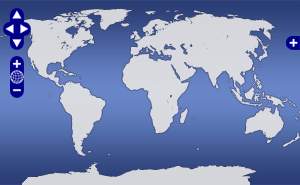3-D P-wave velocity models of Orca Volcano, Bransfield Basin, Antarctica from the BRAVOSEIS experiment
This data set contains three 3-D P-wave upper crustal velocity models for Orca Volcano in the Bransfield Basin, Antarctica. The models were derived from the travel-time inversion of first and secondary arrivals interpreted from active-source ocean-bottom seismometer data acquired as part of the Bransfield Volcano Seismology (BRAVOSEIS) experiment. The tomographic experiment was conducted on Orca Volcano and the ridges extending to the west and southwest using 16 ocean bottom seismometers (OBS), each equipped with a three-component seismometer and hydrophone. Fifteen instruments were US short-period Ocean Bottom Seismograph Instrument Pool (OBSIP) seismometers, and one was a German Instrument Pool for Amphibian Seismology (DEPAS) broadband OBS. The OBS network had an instrument spacing of 3-4 km around the volcano with 3 OBS in the caldera area ~1.5 km apart. One OBS was not recovered. For the tomography experiment, a total of 2426 air gun shots were fired with a 6-gun 2540-cubic inch (41.6 L) array. Shots were spaced 200 m apart along shot lines totaling 485 km in length. Most shots were on twenty-one 21-km-long lines oriented southwest-northeast and spaced 0.5 to 1 km apart with the highest shot density above the caldera and the southwest ridge. To generate deeper ray paths from the northeast, tomography shots were also obtained along two curved lines running southeast-northwest. This active-source tomography experiment imaged the 3-D isotropic and anisotropic P-wave (Pg) velocity structure of the upper crust of Orca Volcano. The three velocity models presented here are described as follows. The Pg Anisotropic Model improves the Pg isotropic model by incorporating anisotropy into the velocity model. These initial isotropic and anisotropic models have file names of Pg_Orca_velocity.nc and Pg_Anis_Orca_velocity.nc, respectively. Additionally, a method was developed to incorporate secondary arrivals to further improve the model. This Pmc Isotropic model, with file name Pg_Pmc_Orca_velocity.nc, significantly improves the image of the volcano magma chamber compared to the Pg Isotropic Model. The origin of the 3-D model grid is centered on the Southwest rift to image the associated rift zones around Orca Volcano. The origin of the grid was set at 58.4400°S, 62.4413°W. The x-axis of the grid is rotated 36 degrees counter clockwise from east such that the x-axis runs NE-SW. The volume of the grid is 27 x 20 x 10km, and has the four corners defined in latitude/longitude as: Bottom-left (Southwest): (-62.5772, -58.5145); Bottom-right (Southeast): (-62.4343, -58.0913); Top-left (Northwest): (-62.4317, -58.7417); Top-right (Northeast): (-62.2896, -58.3194). The seismic velocity models are in netCDF format and contain longitude, latitude, Z in km, and P-wave velocity in km/s. Model seafloor depth (in km) is in the accompanying bathymetry netCDF file. This work has been funded by the National Science Foundation (ANT-1744651 and ANT-1744581), project BRAVOSEIS (CTM201677315-R) of the Spanish Ministry of Science, and Alfred Wegener Institute.
Kidiwela, Maleen
Investigator
UW
Wilcock, William
Investigator
UW
Soule, Dax
Investigator
CUNY:Queens College
Almendros, Javier
Investigator
University of Granada, Spain
Device Info
Seismic:
Platform
NotProvided
Awards
Data DOI
Quality
2
The data have been processed/modified to a level beyond that of basic quality control (e.g. final processed sonar data, photo-mosaics).
License
Data Files
Documents
Data Citation Information
ISO/XML Metadata
Expand

 Map View
Map View

